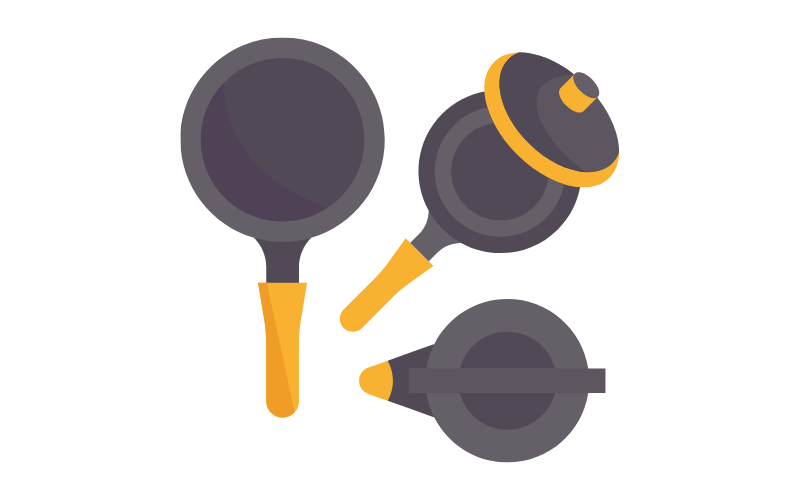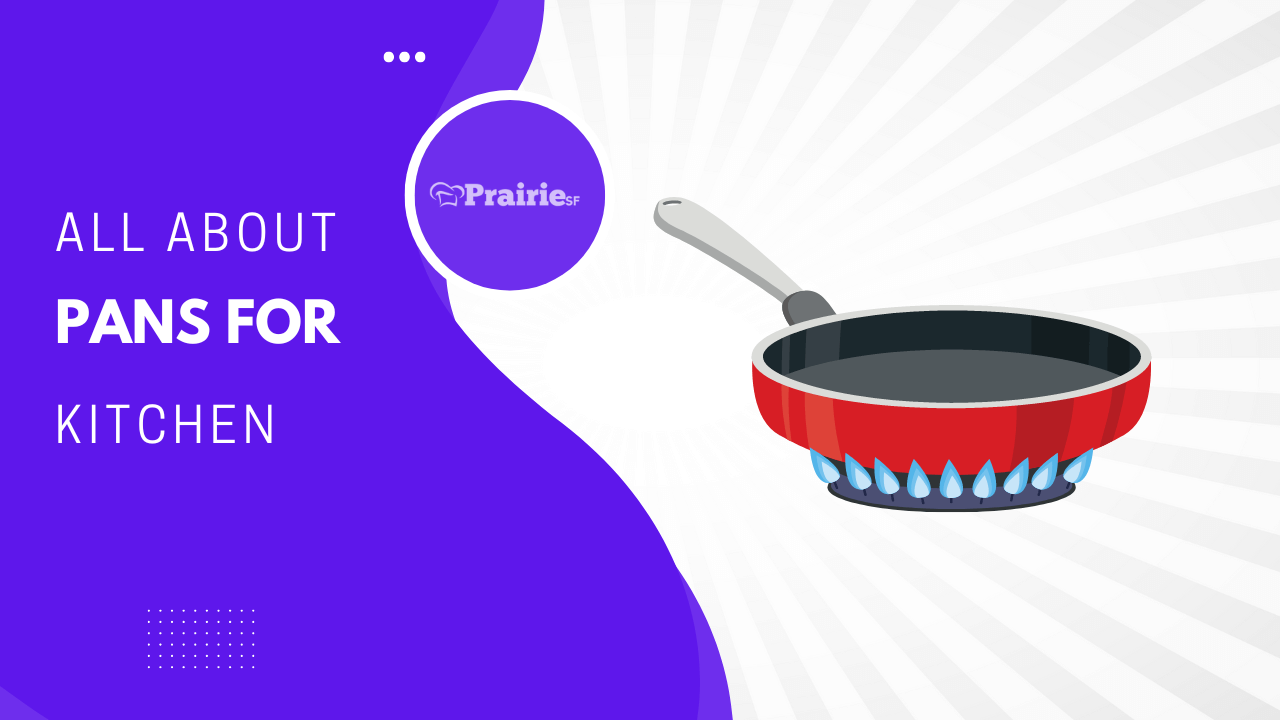Well, we all know what a pan is, but for those who don’t, it’s a kitchen utensil that’s flat at the bottom and raised on the sides for holding and preparing food nicely and easily.
Pans are known for their multiple utility properties, and in a pan, food can be heated or cooled down without being spoiled or broken, and it’s easy to remove food from a pan and much easier to clean.
Pans are made of various materials like aluminum, cast iron, copper, stainless steel, and ceramic or glassware.

Contents
Types Of Pan
There are various categories of pans that people in their kitchens use. Some of them are listed below-
-
Fry Pan/Skillet
It is one of the most common types of pans used in a kitchen, and it is multipurpose as it can be used for flipping omelets, stir-frying, or preparing proteins in a convenient and right way.
These pans are designed so that they have a flat bottom and curved sides, making them your perfect companion in the kitchen, as it’s easy and convenient to flip your food over or simmer oils in them.
The material of the pan and how hot the pan gets, as we know, should maintain a specific temperature or it will ruin the top layer of their coating.
On the other hand, stainless steel is known for its high heat tolerance when used on a high-heat flame. The answer is easily available; they are in different sizes and mostly contain a No-Lid.
Design. -
Cast-Iron Skillet
These pans are similar to the frying pan but different as they are made of another metal and need to be taken care of differently.
They are made of metal, which is heavy, and these skillets are heavy because they are made of cast iron. When selecting a cast-iron skillet, ensure it is pre-seasoned so that there is no issue with food sticking to the pan.
-
Saute Pan
the word “sauté” is a self-explanatory word that means “a pan that is used for sautéing.”Your food is in a pan in which it’s easier to fry and cook as we can move the food, and it also has a lid to properly cover it.
These pans are similar to frying pans but different in that they have a flat bottom and their sides are straight, not rounded like a frying pan.
By the look of it, we can tell that a sauté pan is deeper than a frying pan. A saute pan has many uses, including sauteing but also deep frying, searing, and even preparing sauces like Mariana sauce, etc.
-
Sauce Pan
There are different types of fans, and the shared kitchen utensil among them is a saucepan.
A saucepan with a grounded bottom, a tall, straight side, and a unique lid design that distinguishes it from the rest of the kitchen utensils make its way out of the box.
These pans are very versatile as they make soups and sauces with a saucepan and with or without the lid, we have proper control of evaporation while cooking, which makes it easier and brings an idol kitchen pal on board.
A saucepan is ideal for many other reasons, such as making noodles, boiling eggs, or heating leftovers. It is a versatile pan utensil used in our kitchen that is multipurpose and easy to clean.
Why Does A Professional Chef Use A Stainless Steel Pan?
When a chef cooks, it’s not only what he cooks but also its versatility that makes him stand out from the crowd.
The quality should never be compromised, and for that, the cookware he uses plays a very vital role; it makes all the difference in the quality and taste of the dish.
For a chef, the most critically important piece of equipment in a kitchen is his pan, as they are used in every other dish, from making sauces to cooking pasta.
In restaurants, they use a variety of pans, such as stainless steel pans, cast iron pans, aluminum pans, etc. But for a chef, the first preference goes to a stainless steel pan.
Stainless steel is a very good material that is easy to use, does not peel or chip off easily, and most importantly, does not scratch, unlike aluminum, which is a soft metal.
One more thing to add about stainless steel is that it’s used in cooking, which doesn’t make the food go acidic when it comes in contact with heat.
Like in aluminum cookware, you have the downside of naturally turning the food acidic. Stainless steel doesn’t harm the food, as it doesn’t leach, which results in a healthier and tastier version of dishes.
What Is The Safest Fry Pan?
The safest pan for frying should be one that does not leach chemicals into the food. Some of them are listed below-
-
Cast Iron
Iron mostly leaches out into our food, but it’s generally on an acceptable scale, safe, known for its desirability, and easily available.
Don’t forget to pre-season your cast iron pan to avoid that metallic taste, and use ceramic or glass cookware when you cook acidic foods like sauces.
-
Stainless Steel
Stainless steel is a composition of nickel and chromium. If you want to stop your food from getting leached, right after cooking, remove it from the steel pan into a non-metallic storage container.
It’s a very durable material, and it’s known for being recyclable. It’s also a light, durable, and easy material to use in cookware.
-
Glass
From ancient times, glass has been used in cooking. Bakeware is commonly used in our lives and is cheaper than other materials.
Glass is not that versatile in cooking, as it expands and breaks. Most glassware is incompatible with gas stoves, so the glass is not commonly used as a cookware material.
Why Does Everything Stick To My Stainless Steel Pan?
You will all agree that we have burned your favorite eggs on the bottom of your pan, due to some or the other reasons,
When it comes to frying pans, it’s always not our fault; the cookware can have issues; when we heat the pan, its metal expands, which makes the eggs get trapped in microscopic cracks, where it sticks and burns.
As we know, eggs are liquid, which flows into the cracks and burns them, and they have protein, which is problematic.
According to a study, protein-rich foods are particularly problematic when it comes to sticking to the pan because the proteins can form complexes.
Metal atoms, such as iron in the pan, because of high protein and low-fat foods like chicken and fish, which tend to stick on the pan as they lack in fat and are high in lean protein.
The meat sticks to the pan as they lack lubrication from fats, we can use barriers between the pan and the food by adding oil to the dish.
We could also use grill-like dimpled and irregular pan surfaces, which make lesser contact with food, and it’s essential to pat dry your protein meats (like chicken and fish) before they are placed on a hot pan, as they instantly evaporate the water.
Disadvantages Of Stainless Steel Pans
The following are the disadvantages of stainless steel pans-
- Stainless steels are not the best heat conductors
- There is no such policy as no-oil policy, as that could be done in a non-stick pan
- Cheap-quality steel cookware could have metals like nickel and chrome. They leak metal into your food which, when Cooked with foods for a long time, can cause harm to your health
- They can be susceptible to corrosion depending on the amount of nickel or manganese used in making the stainless steel
- They can be a bit expensive compared to nonstick pans
- The food sticks to the bottom of the pan as they are not nonstick pans, and there should be special attention given while handling delicate food in them
- These utensils are not easy to clean, and as they are not non-stick pans, the food does not come off easily so they might develop brown spots and discoloration on their surface
- Inconsistent cooking performance as they come in various options, we need to understand what we are buying, as some of them are cheap quality cookware and they deliver inconsistent cooking.
- These cookwares are not user-friendly as they are heavy, especially if they are 5-ply ( five bonded layers.
- Cooking with stainless steel requires skills, and it’s not easy to use for a newbie in the kitchen, so you should use a non-stick pan first, then use it later
When Should You Throw Away Non-Stick Frying Pans?
Non-stick pans are covered by a chemical called Teflon, which is why it is so much easier to cook with a non-stick pan than a steel pan.
But the problem is Teflon breakdown, which is a major concern as it causes various health issues, including cancer.
Thus, you should decide on getting rid of your pan under the following circumstances-
-
Wrapping Of Pan
If you have used your nonstick pan for years and are dealing with wrapped cookware, they usually wrap due to heat and dampness, which causes the surface to turn uneven.
Due to unequal surfaces, the food sticks in sections, which causes the food to be uncooked and leads to digestive issues.
-
Discoloration
Every utensil has a lifespan Provided it’s regularly used and adequately stored if there is a dark discoloration of the nonstick pan, that’s a clue to change your pan as its coating is compromised. This coating can come off and cause discomfort when consumed by anyone.
-
Scratches
Scratches are a big no-no When it comes to stainless steel the pans get scratched, and the cookware needs to be replaced immediately.
Nonstick pans using Teflon or carbon steel could have a natural surface containing toxic chemicals that, if contacted, can cause many health issues like cancer and much more severe.
Are Any Non-Stick Pans Safe?
Yes, using non-stick pans is safe; Teflon manufacturers have removed the compound from their pans entirely.
After 2013, as per the Stockholm Convention, all the products used After this year, PFOA will be free from By all means, the compound perfluorooctanoic acid Teflon cookware can be used once in a while on a low flame.
Some alternatives for a safer cooking experience-
- Use stainless steel.
- Look for PFOA-free cookware.
- Cast iron cookware
- Use carbon steel utensils.
Conclusion
There are different kinds of kitchen cookware that one can use, and after a thorough inspection, one can easily make out which pan is suitable for them.
Every cookware item has its unique selling point, and one can get an idea by going through the article, that is, what a pan is and its various types, options, and advantages as well.
When a person is looking to buy kitchen utensils, they want to buy something convenient, easy to carry, and not compromise their needs.
I have tried to highlight some of the best cooking ware material, from which one can easily pick out their favorite, as good quality cookware is essential to establish a good quality of food experience in the kitchen.

